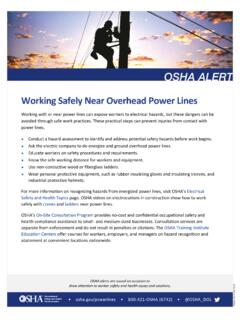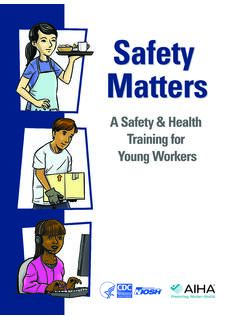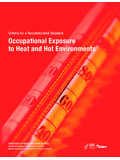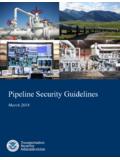Transcription of Small Business Safety and Health Handbook
1 Small Business Safety and Health HandbookDHHS (NIOSH) Publication Number 2021-120 | OSHA Publication Number 2209-07R 2021 Small Business Safety and Health Handbook iii | Small Business Safety AND Health HANDBOOKC ontentsAbout this Handbook ..1 Safety and Health Programs ..2 Value of a Safety and Health Program ..2 Implementing a Safety and Health Program ..3 Workplace Self-Inspection ..4 Self-Inspection Checklists ..4 General ..5 Safety and Health Programs ..5 General Work Environment and Housekeeping ..7 Posting of Required Safety and Health Information ..9 Recordkeeping and Reporting ..10 Compressed Gas Cylinders ..12 Electrical Safety .
2 13 Exit Routes and Emergency Planning ..17 Doors ..17 Emergency Action Plans ..19 Exits, Exit Paths (Means of Egress) ..22 Fire Protection ..24 Fire Extinguishers ..24 Fire Suppression and Alarm Systems ..25 Flammable and Combustible Liquids and Materials ..26 Hand and Portable Powered Tools and Equipment ..28 Explosive (Powder) Actuated Fastening Tools ..28 Hand Tools and Equipment ..29 Portable (Power Operated) Tools and Equipment ..31 Hazard Communication and Chemicals ..32 Hazard Communication ..32 Hazardous Chemicals ..34 iv | Small Business Safety AND Health HANDBOOKL ockout/Tagout Procedures ..36 Machinery and Machine Guarding.
3 38 Abrasive Wheel Equipment Grinders ..38 Machinery and Equipment ..40 Materials Handling and Storage ..43 Hoist and Auxiliary Equipment ..43 Materials Handling ..46 Powered Industrial Trucks ..47 Medical Services and First Aid ..49 Noise Exposure ..51 Permit-Required Confined Spaces ..53 Personal Protective Equipment (PPE) ..56 Respiratory Protection ..58 Walking-Working Surfaces ..60 Elevated Surfaces ..60 Floor Holes and Wall Openings ..61 Portable Ladders ..62 Stairs and Stairways ..64 Walkways ..65 Welding, Cutting, and Brazing ..67 Safety and Health Assistance for Small Businesses ..71 OSHA Resources ..71 Whistleblower Program: Protection from Retaliation.
4 74 State Plans ..75 National Institute for Occupational Safety and Health (NIOSH) Resources ..75 Other Resources ..76 The Small Business Regulatory Enforcement Fairness Act of 1996 (SBREFA) ..76 OSHA Regional Offices ..77 Contact OSHA ..78 1 | Small Business Safety AND Health HANDBOOKA bout this HandbookThe Occupational Safety and Health Administration (OSHA) and the National Institute for Occupational Safety and Health (NIOSH) developed this Handbook to provide Small Business employers with workplace Safety and Health information .The Handbook summarizes the benefits of an effective Safety and Health program, provides self-inspection checklists for employers to identify workplace hazards , and reviews key workplace Safety and Health resources for Small businesses.
5 This Handbook is a general guide . Employers should not use it to assess compliance with the Occupational Safety and Health Act of 1970 (OSH Act) or federal OSHA standards . This Handbook does not provide legal interpretations of the requirements in OSHA standards, nor does it create any additional compliance requirements for employers . OSHA will not cite employers under the General Duty Clause in Section 5(a)(1) of the OSH Act for not following the Handbook s recommendations .More than 20 states and territories operate their own OSHA-approved State Plans . A list of states that operate their own State Plans can be found on OSHA s website.
6 While the Safety and Health compliance requirements in these State Plans may differ in some respects from federal OSHA requirements, employers in all states may benefit from using this Handbook . This publication is in the public domain and copyright-free . You can share it, fully or partially, without permission . We appreciate, but do not require, source credit . Photo: iStock 2 | Small Business Safety AND Health HANDBOOKS afety and Health ProgramsValue of a Safety and Health ProgramEvery year, more than 5,000 workers are killed on the job (average of 14 deaths per day), and more than 3 .6 million suffer a serious job-related injury or illness.
7 Even one serious workplace injury or illness can have a devastating impact on a Small Business , including costs associated with higher workers compensation premiums, medical expenses, legal fees, replacement worker training, lost productivity, equipment repairs, and lower worker morale to say nothing of the overwhelming personal impacts . Implementing a Safety and Health program helps businesses: Prevent workplace injuries and illnesses Improve compliance with laws and regulations Reduce costs, including significant reductions in workers compensation premiums Engage workers Enhance social responsibility goals Increase productivity and enhance overall Business operationsSmall employers like you place a high value on the well-being of your workers.
8 Like many Small businesses, you may employ family members and personal acquaintances . And, if you don t know your workers before they are hired, the size of your workplace will promote the closeness and concern for one another that Small businesses value .OSHA and NIOSH provide helpful resources and want to work with you to promote a safe and healthful workplace . Employers that make job Safety and Health a real part of their everyday operations will benefit in the long run . Investing in a Safety and Health program now will help you avoid possible losses in the future . A safe Business is a sound Business .The main goal of a Safety and Health program is to prevent workplace injuries, illnesses, and deaths, as well as the suffering and financial hardship these events can cause for workers, their families, and employers.
9 Traditional approaches are often reactive; that is, problems are addressed only after a worker is injured or becomes sick, a new standard or regulation is published, or an outside inspection finds a problem . OSHA s Safe + Sound campaign encourages every workplace to have a Safety and Health program . Through this campaign, OSHA works with NIOSH and other organizations to provide resources to help employers develop Safety and Health programs and to recognize the successes of these programs .Photo: iStock 3 | Small Business Safety AND Health HANDBOOKI mplementing a Safety and Health ProgramOSHA s Recommended Practices for Safety and Health Programs use a proactive approach to managing workplace Safety and Health , recognizing that finding and fixing hazards before they cause injury or illness is a far more effective approach.
10 The Recommended Practices present a step-by-step approach to implementing a successful Safety and Health program, built around seven core elements: Management leadership Worker participation Hazard identification and assessment Hazard prevention and control Education and training Program evaluation and improvement Communication and coordination for host employers, contractors, and staffing agenciesOSHA s website includes tools to help employers implement Safety and Health programs, including: how to get started, a Safety and Health program self-evaluation tool, a Safety and Health program implementation checklist, and a Safety and Health program audit tool.














